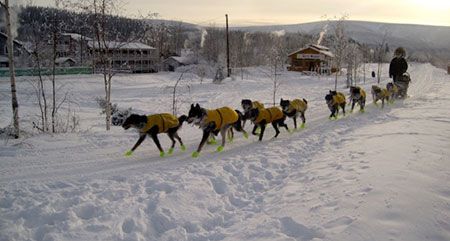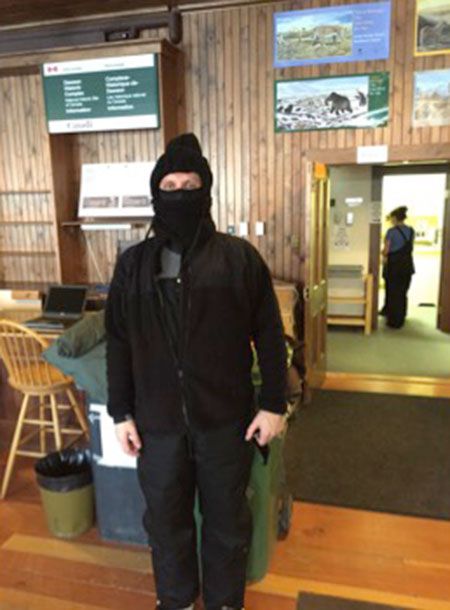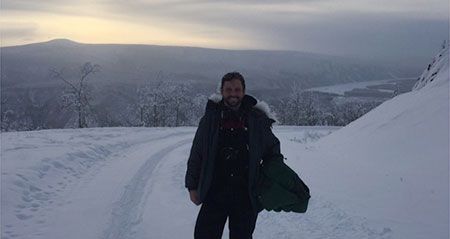My Yukon Quest experience
While working on my board certification for sports medicine and rehabilitation, I had the amazing opportunity to work with sled dogs.

The dogs ready at the start of the race. | All photos courtesy of Dr. Brunke
I graduated from Ross University in 2004 and enjoyed being in general practice for a decade. Along the way, I got certified in rehabilitation and started to focus on the developing field of canine sports medicine.
I left general practice in 2014 and moved to specialty medicine as the head of a rehab department, working alongside boarded internists, surgeons, cardiologists and other specialists. I knew the AVMA had recognized the field of sports medicine and rehabilitation as a specialty college in 2010, and in 2014 two friends and colleagues helped me take the plunge. I then began my practice experience pathway to becoming a diplomate in sports medicine and rehabilitation.
As with most specialty colleges, a requirement to sit for boards is being a first or second author on a research paper. In meeting with my mentor, Joe Wakshlag, DVM, PhD, DACVN, DACVSMR, we talked about different research opportunities. His interest and hobby is racing sled dogs, so we looked at races that could provide opportunities for practical research.
This search brought me to the 2015 Yukon Quest, a 1,000-mile sled dog race. In odd number years it starts in Whitehorse, Yukon Territory, Canada, and ends in Fairbanks, Alaska. On even number years, the course is reversed.

A map of the race course.
Dr. Wakshlag and I put together a research proposal to assess mechanisms of energy consumption that would involve three of the teams participating in the 2015 race. We would draw blood samples prior to the race start, at the checkpoint halfway and at the end of the race.
The research team included Dr. Wakshlag; Chris Frye, DVM, DACVSMR; my resident mate and myself. We arrived in Whitehorse a few days before the race, and the initial blood samples were obtained.
Watching the start of the race was amazing. If you haven't seen a sled dog race, I highly recommend it. To watch the dogs get the sled and musher moving, and then the roar of the crowd as each team leaves town, is truly worth it.

A team heading out.
There was also a team of veterinarians along the course to ensure the well-being of the dogs. Led by Nina Hansen, DVM, PhD, these veterinarians checked each of the 14 dogs on all 20 teams and then at each waypoint (about every 100 to 150 miles). It was truly incredible to behold, as they meticulously examined every dog, ensuring they were safe to continue on the race.
Dr. Frye and I drove to each checkpoint, and we had a great time meeting the veterinary team, the support team for the mushers, spectators and local folks along the way. Dr. Wakshlag had to head back to Cornell, so he took the pre-race blood samples with him.
It was unusually cold that year. Normally the temperatures are around 15 to 20 degrees F, potentially reaching 0. That year, at the coldest, it was -54 F and brutally cold out on the frozen Yukon River, which was essentially the trail the dogs followed.

Here I am wearing lots of layers to stay warm.
Normally sled dogs will eat snow for water intake, but the ground was so cold some dogs couldn't get enough water and dropped from the race with rhabdomyolysis. This is a condition where their muscle tissue breaks down and they can have tremors, hyperthermia (some dogs had temps of 105 F!), and dark red urine, consistent with myoglobinuria. The veterinarians were inundated with the check-ins, so Dr. Frye and I pitched in and helped run a triage room, providing IV fluids, muscle relaxants and care for the afflicted dogs. All dogs survived, and we got additional blood samples from those dogs to learn more about this disease.
In the town of Dawson, we waited for our teams to come in. Here we got to see the Northern Lights and hiked to the top of the mountain in the town. Our three teams came in at different times of the day, so Dr. Frye and I drew blood in the afternoon, evening and even at 4 a.m. We needed to draw blood within two hours of the teams checking in. We didn't have an indoor facility in Dawson, so we drew blood outside, under a tarp, by headlamp. The tarp was used to provide wind protection for the dogs, so it was only three to four feet off the ground. I am 6 feet 4 inches tall, and Dr. Frye is 6 feet 8 inches tall, so it made for entertaining work.

Almost at the top of the mountain.
Without exception, every dog was amazing for blood draws. They had just run 150 miles or so, in brutal weather, and each one was wonderful. None of them growled or had to be muzzled. If I had just run that far, I doubt I would have been so accommodating for a blood draw. Sled dogs are truly amazing dogs, and I hope you get a chance to experience them firsthand.
After drawing blood, we then spun it in our hotel room (yep, we brought a centrifuge with us to the Arctic) and then separated the serum into tubes and froze it. Freezing it was easy; we literally put it outside in the snow! Once it was prepared, we shipped it back to our laboratory on dry ice.
Following the halfway point blood collection, I had to head back home, but Dr. Frye took a tiny plane (the roads are closed in winter) from Canada to Alaska, and then got blood samples in Fairbanks at the finish line.

Dogs relaxing at a waypoint.
Then we worked with our research team to analyze the data and publish our results. We had great comparison, as one of our teams was not able to complete the race, one finished in the middle of the competitors and one came in first place!
The dogs, mushers and all the folks along the way were truly inspiring. I had a fantastic time and it left a lasting impression of a different aspect of veterinary medicine on me. You can apply to be a race veterinarian or go up as a spectator. I hope to see you there, as I plan to go back soon.
For more information:
https://www.ncbi.nlm.nih.gov/pmc/articles/PMC5027292/
Dr. Matthew Brunke is a diplomate of the American College of Veterinary Sports Medicine and Rehabilitation and practices at Veterinary Orthopedic and Sports Medicine Group in Annapolis Junction, Maryland.